The Geology of Sidney Basin
VerifiedAdded on 2022/12/16
|11
|2618
|465
AI Summary
This article explores the sedimentology, stratigraphy, and paleo environments of Sidney Basin in Australia. It discusses the sequential geological history, sedimentary rocks, and principal sedimentary environments. The basin is filled with Permian shales and Triassic sandstones, and it has undergone uplift, folding, and faulting. The sedimentary environments include fluvial and shallow marine systems, coal measures, and embayment and shallow marine formations. Changes in sedimentary environments are influenced by erosion, climate change, and tectonism.
Contribute Materials
Your contribution can guide someone’s learning journey. Share your
documents today.
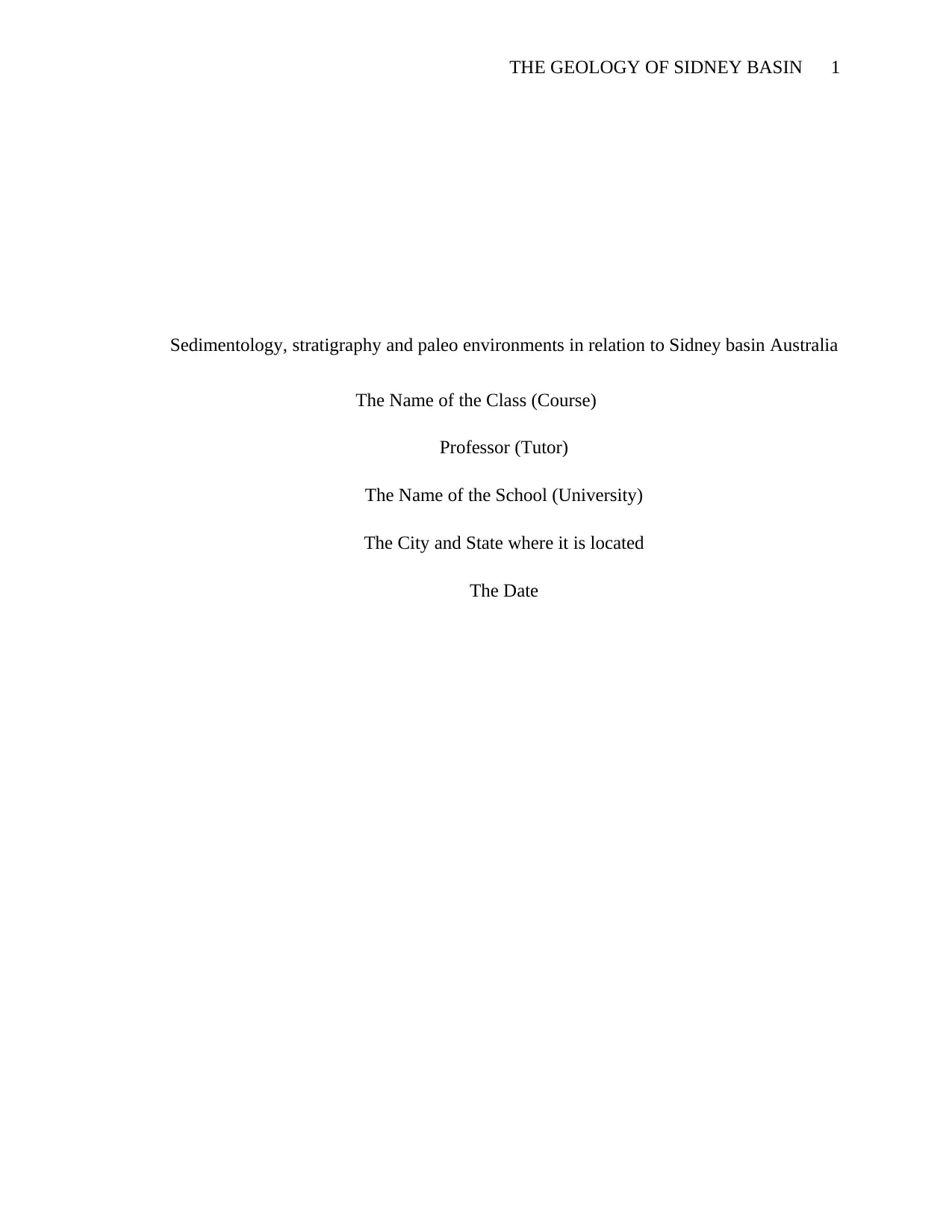
THE GEOLOGY OF SIDNEY BASIN 1
Sedimentology, stratigraphy and paleo environments in relation to Sidney basin Australia
The Name of the Class (Course)
Professor (Tutor)
The Name of the School (University)
The City and State where it is located
The Date
Sedimentology, stratigraphy and paleo environments in relation to Sidney basin Australia
The Name of the Class (Course)
Professor (Tutor)
The Name of the School (University)
The City and State where it is located
The Date
Secure Best Marks with AI Grader
Need help grading? Try our AI Grader for instant feedback on your assignments.
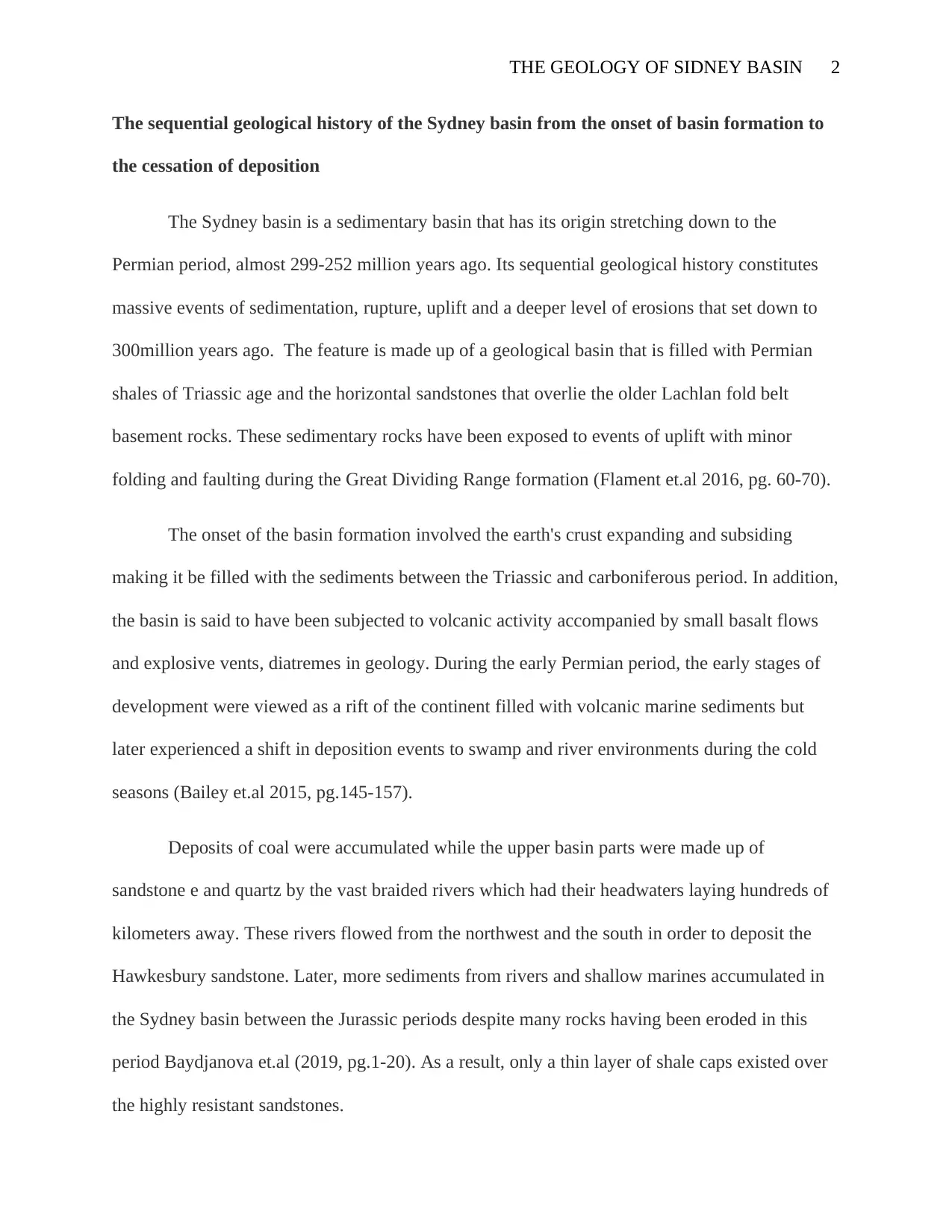
THE GEOLOGY OF SIDNEY BASIN 2
The sequential geological history of the Sydney basin from the onset of basin formation to
the cessation of deposition
The Sydney basin is a sedimentary basin that has its origin stretching down to the
Permian period, almost 299-252 million years ago. Its sequential geological history constitutes
massive events of sedimentation, rupture, uplift and a deeper level of erosions that set down to
300million years ago. The feature is made up of a geological basin that is filled with Permian
shales of Triassic age and the horizontal sandstones that overlie the older Lachlan fold belt
basement rocks. These sedimentary rocks have been exposed to events of uplift with minor
folding and faulting during the Great Dividing Range formation (Flament et.al 2016, pg. 60-70).
The onset of the basin formation involved the earth's crust expanding and subsiding
making it be filled with the sediments between the Triassic and carboniferous period. In addition,
the basin is said to have been subjected to volcanic activity accompanied by small basalt flows
and explosive vents, diatremes in geology. During the early Permian period, the early stages of
development were viewed as a rift of the continent filled with volcanic marine sediments but
later experienced a shift in deposition events to swamp and river environments during the cold
seasons (Bailey et.al 2015, pg.145-157).
Deposits of coal were accumulated while the upper basin parts were made up of
sandstone e and quartz by the vast braided rivers which had their headwaters laying hundreds of
kilometers away. These rivers flowed from the northwest and the south in order to deposit the
Hawkesbury sandstone. Later, more sediments from rivers and shallow marines accumulated in
the Sydney basin between the Jurassic periods despite many rocks having been eroded in this
period Baydjanova et.al (2019, pg.1-20). As a result, only a thin layer of shale caps existed over
the highly resistant sandstones.
The sequential geological history of the Sydney basin from the onset of basin formation to
the cessation of deposition
The Sydney basin is a sedimentary basin that has its origin stretching down to the
Permian period, almost 299-252 million years ago. Its sequential geological history constitutes
massive events of sedimentation, rupture, uplift and a deeper level of erosions that set down to
300million years ago. The feature is made up of a geological basin that is filled with Permian
shales of Triassic age and the horizontal sandstones that overlie the older Lachlan fold belt
basement rocks. These sedimentary rocks have been exposed to events of uplift with minor
folding and faulting during the Great Dividing Range formation (Flament et.al 2016, pg. 60-70).
The onset of the basin formation involved the earth's crust expanding and subsiding
making it be filled with the sediments between the Triassic and carboniferous period. In addition,
the basin is said to have been subjected to volcanic activity accompanied by small basalt flows
and explosive vents, diatremes in geology. During the early Permian period, the early stages of
development were viewed as a rift of the continent filled with volcanic marine sediments but
later experienced a shift in deposition events to swamp and river environments during the cold
seasons (Bailey et.al 2015, pg.145-157).
Deposits of coal were accumulated while the upper basin parts were made up of
sandstone e and quartz by the vast braided rivers which had their headwaters laying hundreds of
kilometers away. These rivers flowed from the northwest and the south in order to deposit the
Hawkesbury sandstone. Later, more sediments from rivers and shallow marines accumulated in
the Sydney basin between the Jurassic periods despite many rocks having been eroded in this
period Baydjanova et.al (2019, pg.1-20). As a result, only a thin layer of shale caps existed over
the highly resistant sandstones.
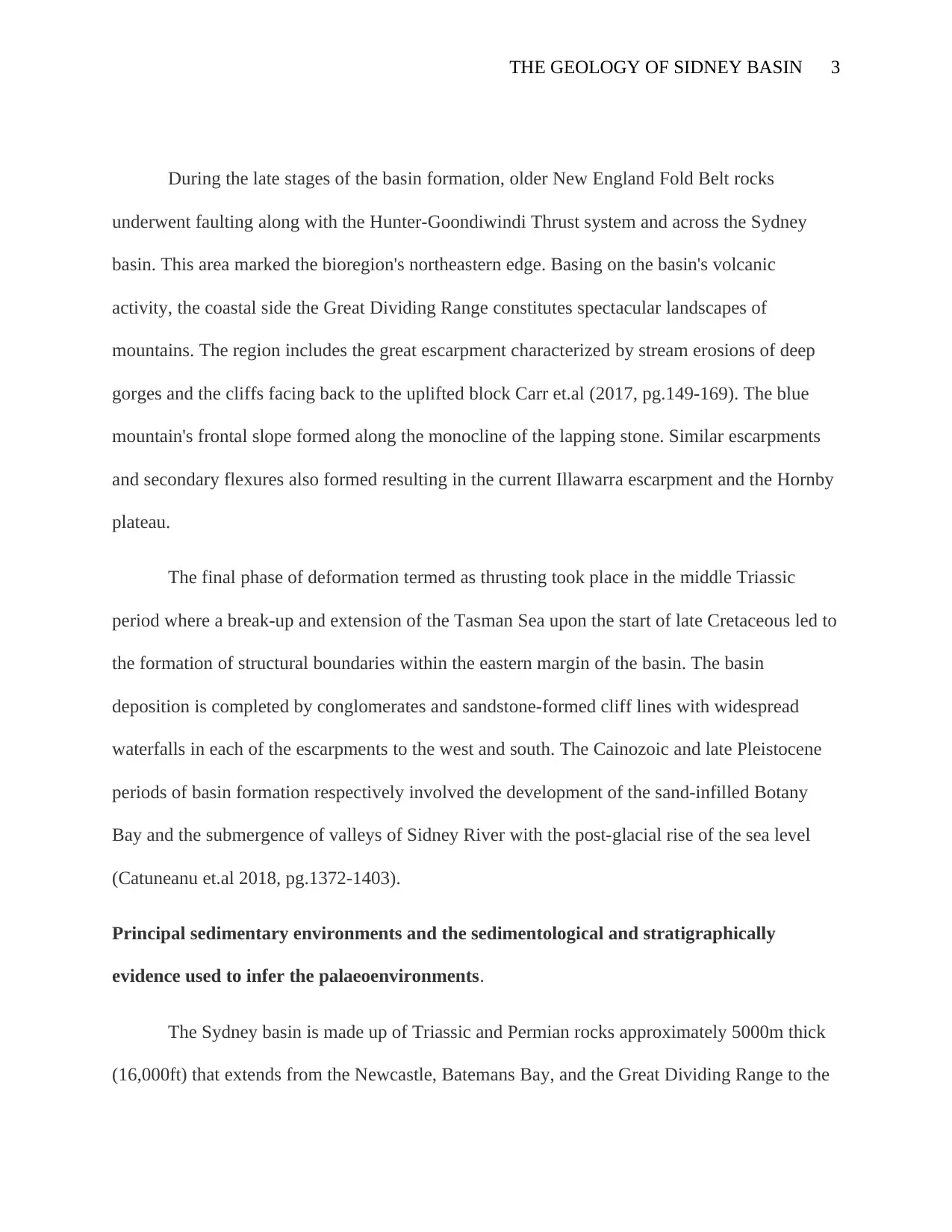
THE GEOLOGY OF SIDNEY BASIN 3
During the late stages of the basin formation, older New England Fold Belt rocks
underwent faulting along with the Hunter-Goondiwindi Thrust system and across the Sydney
basin. This area marked the bioregion's northeastern edge. Basing on the basin's volcanic
activity, the coastal side the Great Dividing Range constitutes spectacular landscapes of
mountains. The region includes the great escarpment characterized by stream erosions of deep
gorges and the cliffs facing back to the uplifted block Carr et.al (2017, pg.149-169). The blue
mountain's frontal slope formed along the monocline of the lapping stone. Similar escarpments
and secondary flexures also formed resulting in the current Illawarra escarpment and the Hornby
plateau.
The final phase of deformation termed as thrusting took place in the middle Triassic
period where a break-up and extension of the Tasman Sea upon the start of late Cretaceous led to
the formation of structural boundaries within the eastern margin of the basin. The basin
deposition is completed by conglomerates and sandstone-formed cliff lines with widespread
waterfalls in each of the escarpments to the west and south. The Cainozoic and late Pleistocene
periods of basin formation respectively involved the development of the sand-infilled Botany
Bay and the submergence of valleys of Sidney River with the post-glacial rise of the sea level
(Catuneanu et.al 2018, pg.1372-1403).
Principal sedimentary environments and the sedimentological and stratigraphically
evidence used to infer the palaeoenvironments.
The Sydney basin is made up of Triassic and Permian rocks approximately 5000m thick
(16,000ft) that extends from the Newcastle, Batemans Bay, and the Great Dividing Range to the
During the late stages of the basin formation, older New England Fold Belt rocks
underwent faulting along with the Hunter-Goondiwindi Thrust system and across the Sydney
basin. This area marked the bioregion's northeastern edge. Basing on the basin's volcanic
activity, the coastal side the Great Dividing Range constitutes spectacular landscapes of
mountains. The region includes the great escarpment characterized by stream erosions of deep
gorges and the cliffs facing back to the uplifted block Carr et.al (2017, pg.149-169). The blue
mountain's frontal slope formed along the monocline of the lapping stone. Similar escarpments
and secondary flexures also formed resulting in the current Illawarra escarpment and the Hornby
plateau.
The final phase of deformation termed as thrusting took place in the middle Triassic
period where a break-up and extension of the Tasman Sea upon the start of late Cretaceous led to
the formation of structural boundaries within the eastern margin of the basin. The basin
deposition is completed by conglomerates and sandstone-formed cliff lines with widespread
waterfalls in each of the escarpments to the west and south. The Cainozoic and late Pleistocene
periods of basin formation respectively involved the development of the sand-infilled Botany
Bay and the submergence of valleys of Sidney River with the post-glacial rise of the sea level
(Catuneanu et.al 2018, pg.1372-1403).
Principal sedimentary environments and the sedimentological and stratigraphically
evidence used to infer the palaeoenvironments.
The Sydney basin is made up of Triassic and Permian rocks approximately 5000m thick
(16,000ft) that extends from the Newcastle, Batemans Bay, and the Great Dividing Range to the
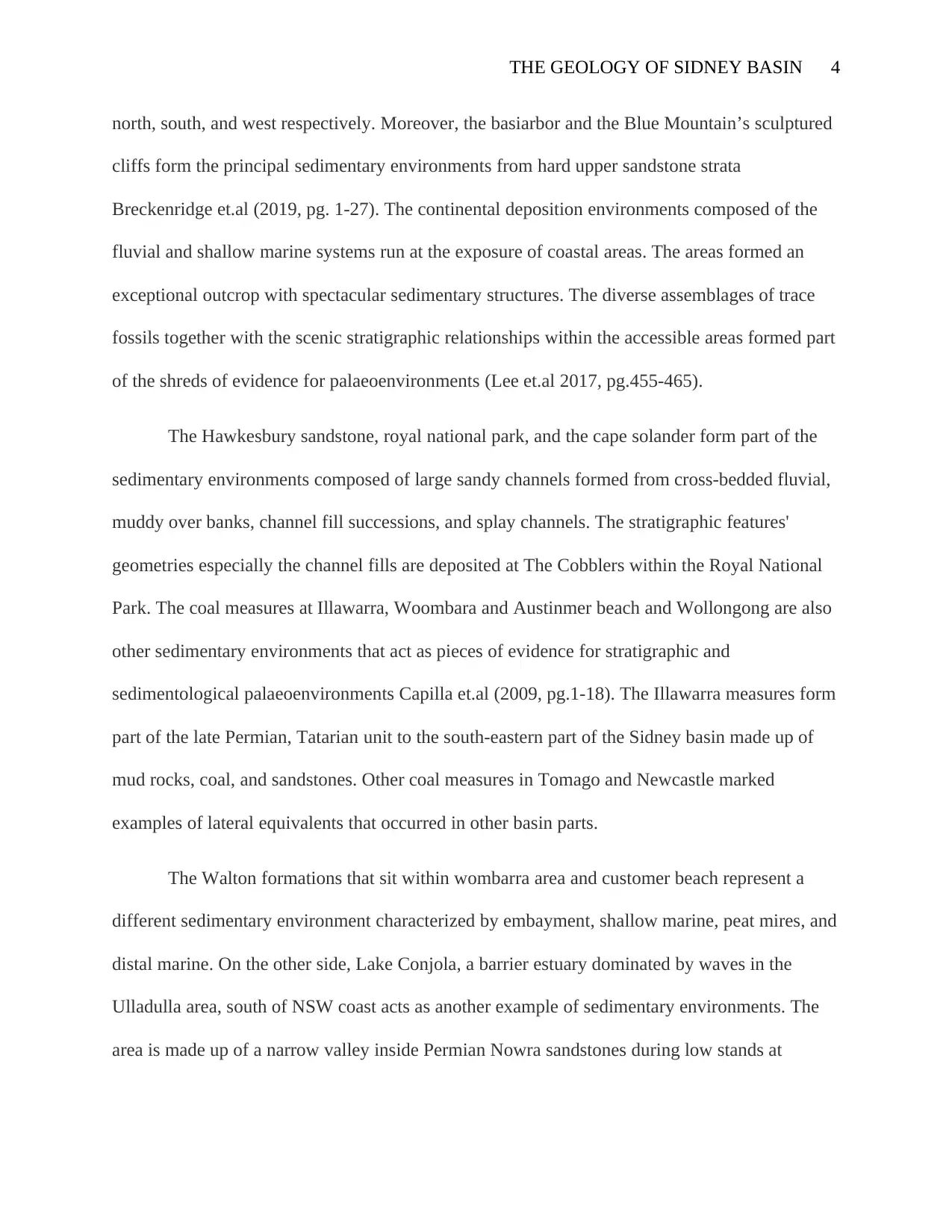
THE GEOLOGY OF SIDNEY BASIN 4
north, south, and west respectively. Moreover, the basiarbor and the Blue Mountain’s sculptured
cliffs form the principal sedimentary environments from hard upper sandstone strata
Breckenridge et.al (2019, pg. 1-27). The continental deposition environments composed of the
fluvial and shallow marine systems run at the exposure of coastal areas. The areas formed an
exceptional outcrop with spectacular sedimentary structures. The diverse assemblages of trace
fossils together with the scenic stratigraphic relationships within the accessible areas formed part
of the shreds of evidence for palaeoenvironments (Lee et.al 2017, pg.455-465).
The Hawkesbury sandstone, royal national park, and the cape solander form part of the
sedimentary environments composed of large sandy channels formed from cross-bedded fluvial,
muddy over banks, channel fill successions, and splay channels. The stratigraphic features'
geometries especially the channel fills are deposited at The Cobblers within the Royal National
Park. The coal measures at Illawarra, Woombara and Austinmer beach and Wollongong are also
other sedimentary environments that act as pieces of evidence for stratigraphic and
sedimentological palaeoenvironments Capilla et.al (2009, pg.1-18). The Illawarra measures form
part of the late Permian, Tatarian unit to the south-eastern part of the Sidney basin made up of
mud rocks, coal, and sandstones. Other coal measures in Tomago and Newcastle marked
examples of lateral equivalents that occurred in other basin parts.
The Walton formations that sit within wombarra area and customer beach represent a
different sedimentary environment characterized by embayment, shallow marine, peat mires, and
distal marine. On the other side, Lake Conjola, a barrier estuary dominated by waves in the
Ulladulla area, south of NSW coast acts as another example of sedimentary environments. The
area is made up of a narrow valley inside Permian Nowra sandstones during low stands at
north, south, and west respectively. Moreover, the basiarbor and the Blue Mountain’s sculptured
cliffs form the principal sedimentary environments from hard upper sandstone strata
Breckenridge et.al (2019, pg. 1-27). The continental deposition environments composed of the
fluvial and shallow marine systems run at the exposure of coastal areas. The areas formed an
exceptional outcrop with spectacular sedimentary structures. The diverse assemblages of trace
fossils together with the scenic stratigraphic relationships within the accessible areas formed part
of the shreds of evidence for palaeoenvironments (Lee et.al 2017, pg.455-465).
The Hawkesbury sandstone, royal national park, and the cape solander form part of the
sedimentary environments composed of large sandy channels formed from cross-bedded fluvial,
muddy over banks, channel fill successions, and splay channels. The stratigraphic features'
geometries especially the channel fills are deposited at The Cobblers within the Royal National
Park. The coal measures at Illawarra, Woombara and Austinmer beach and Wollongong are also
other sedimentary environments that act as pieces of evidence for stratigraphic and
sedimentological palaeoenvironments Capilla et.al (2009, pg.1-18). The Illawarra measures form
part of the late Permian, Tatarian unit to the south-eastern part of the Sidney basin made up of
mud rocks, coal, and sandstones. Other coal measures in Tomago and Newcastle marked
examples of lateral equivalents that occurred in other basin parts.
The Walton formations that sit within wombarra area and customer beach represent a
different sedimentary environment characterized by embayment, shallow marine, peat mires, and
distal marine. On the other side, Lake Conjola, a barrier estuary dominated by waves in the
Ulladulla area, south of NSW coast acts as another example of sedimentary environments. The
area is made up of a narrow valley inside Permian Nowra sandstones during low stands at
Secure Best Marks with AI Grader
Need help grading? Try our AI Grader for instant feedback on your assignments.
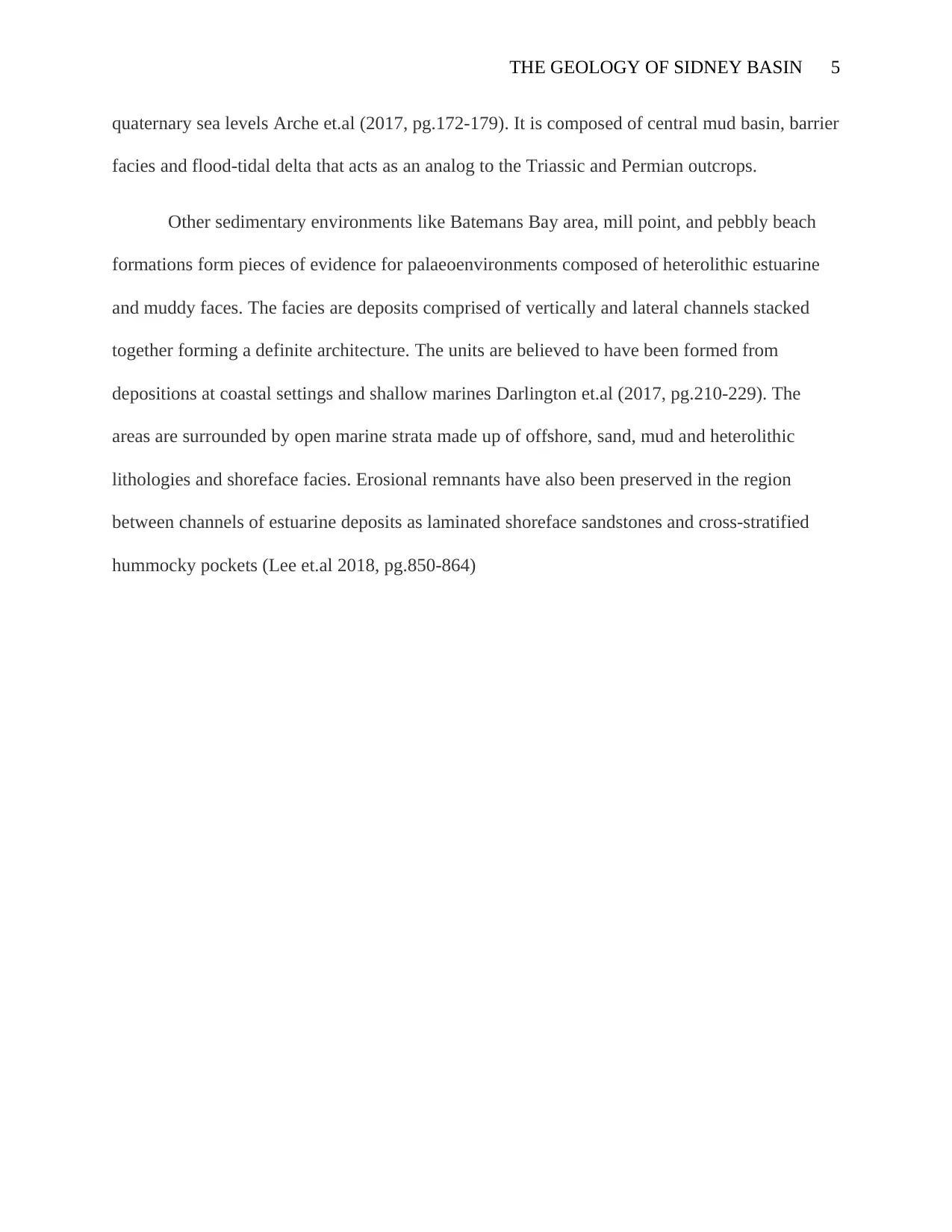
THE GEOLOGY OF SIDNEY BASIN 5
quaternary sea levels Arche et.al (2017, pg.172-179). It is composed of central mud basin, barrier
facies and flood-tidal delta that acts as an analog to the Triassic and Permian outcrops.
Other sedimentary environments like Batemans Bay area, mill point, and pebbly beach
formations form pieces of evidence for palaeoenvironments composed of heterolithic estuarine
and muddy faces. The facies are deposits comprised of vertically and lateral channels stacked
together forming a definite architecture. The units are believed to have been formed from
depositions at coastal settings and shallow marines Darlington et.al (2017, pg.210-229). The
areas are surrounded by open marine strata made up of offshore, sand, mud and heterolithic
lithologies and shoreface facies. Erosional remnants have also been preserved in the region
between channels of estuarine deposits as laminated shoreface sandstones and cross-stratified
hummocky pockets (Lee et.al 2018, pg.850-864)
quaternary sea levels Arche et.al (2017, pg.172-179). It is composed of central mud basin, barrier
facies and flood-tidal delta that acts as an analog to the Triassic and Permian outcrops.
Other sedimentary environments like Batemans Bay area, mill point, and pebbly beach
formations form pieces of evidence for palaeoenvironments composed of heterolithic estuarine
and muddy faces. The facies are deposits comprised of vertically and lateral channels stacked
together forming a definite architecture. The units are believed to have been formed from
depositions at coastal settings and shallow marines Darlington et.al (2017, pg.210-229). The
areas are surrounded by open marine strata made up of offshore, sand, mud and heterolithic
lithologies and shoreface facies. Erosional remnants have also been preserved in the region
between channels of estuarine deposits as laminated shoreface sandstones and cross-stratified
hummocky pockets (Lee et.al 2018, pg.850-864)
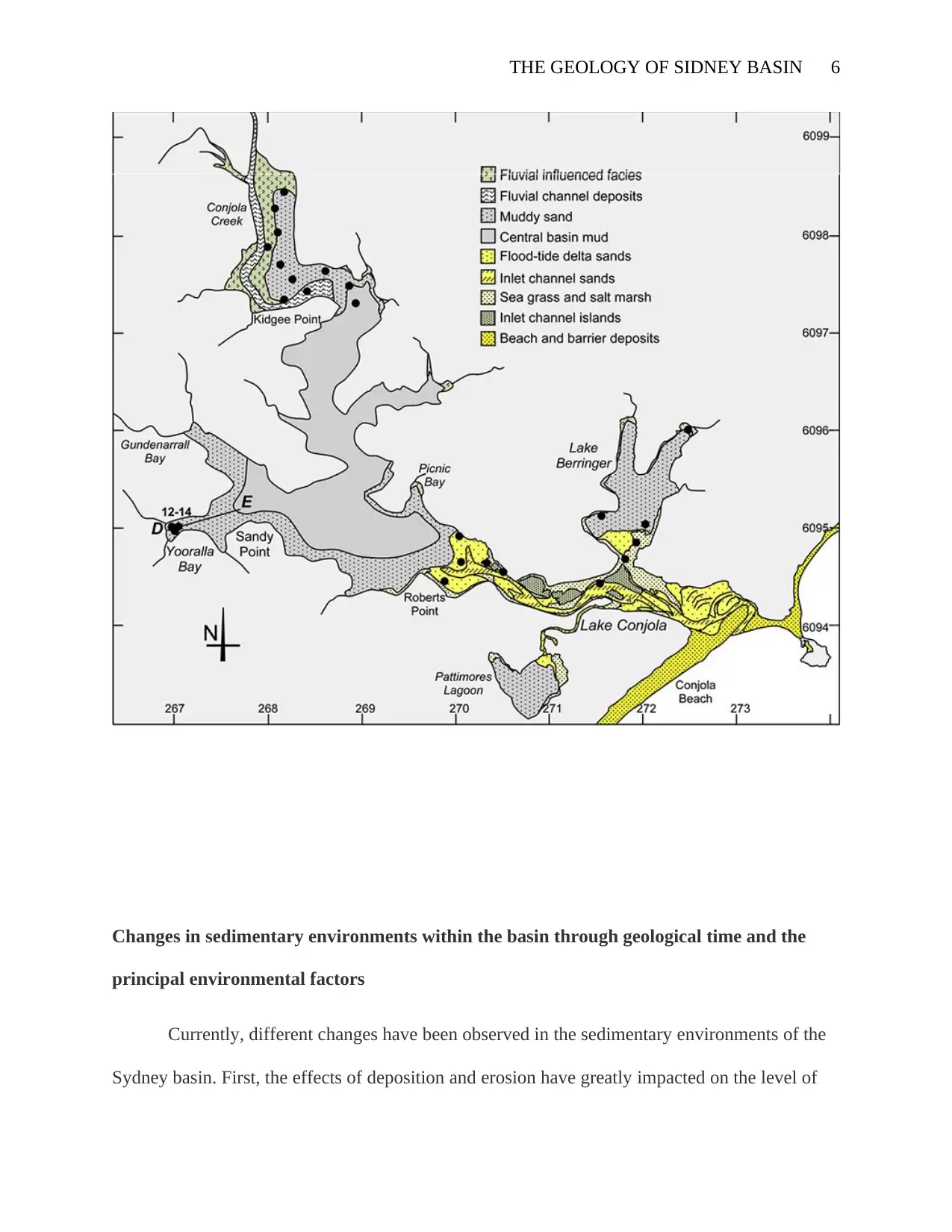
THE GEOLOGY OF SIDNEY BASIN 6
Changes in sedimentary environments within the basin through geological time and the
principal environmental factors
Currently, different changes have been observed in the sedimentary environments of the
Sydney basin. First, the effects of deposition and erosion have greatly impacted on the level of
Changes in sedimentary environments within the basin through geological time and the
principal environmental factors
Currently, different changes have been observed in the sedimentary environments of the
Sydney basin. First, the effects of deposition and erosion have greatly impacted on the level of
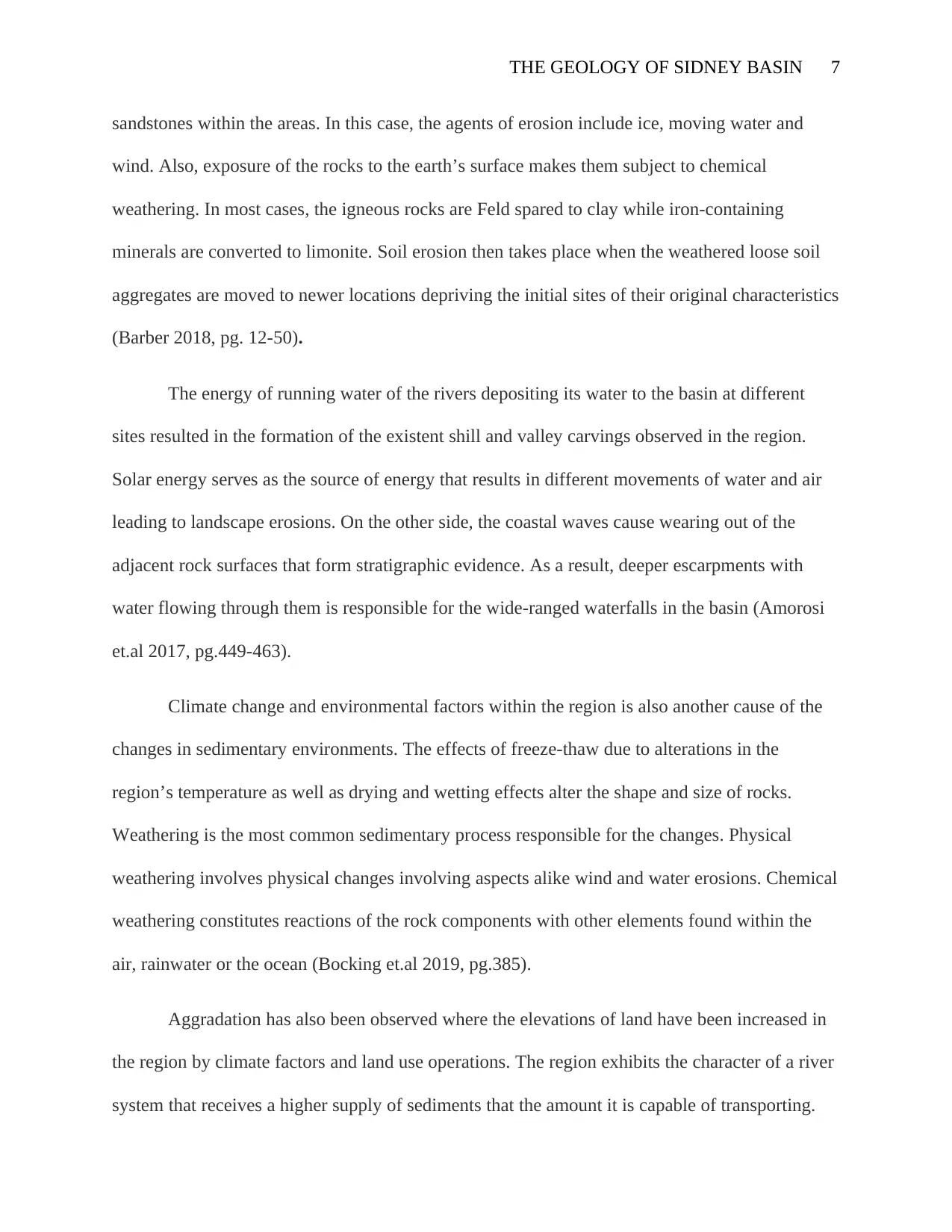
THE GEOLOGY OF SIDNEY BASIN 7
sandstones within the areas. In this case, the agents of erosion include ice, moving water and
wind. Also, exposure of the rocks to the earth’s surface makes them subject to chemical
weathering. In most cases, the igneous rocks are Feld spared to clay while iron-containing
minerals are converted to limonite. Soil erosion then takes place when the weathered loose soil
aggregates are moved to newer locations depriving the initial sites of their original characteristics
(Barber 2018, pg. 12-50).
The energy of running water of the rivers depositing its water to the basin at different
sites resulted in the formation of the existent shill and valley carvings observed in the region.
Solar energy serves as the source of energy that results in different movements of water and air
leading to landscape erosions. On the other side, the coastal waves cause wearing out of the
adjacent rock surfaces that form stratigraphic evidence. As a result, deeper escarpments with
water flowing through them is responsible for the wide-ranged waterfalls in the basin (Amorosi
et.al 2017, pg.449-463).
Climate change and environmental factors within the region is also another cause of the
changes in sedimentary environments. The effects of freeze-thaw due to alterations in the
region’s temperature as well as drying and wetting effects alter the shape and size of rocks.
Weathering is the most common sedimentary process responsible for the changes. Physical
weathering involves physical changes involving aspects alike wind and water erosions. Chemical
weathering constitutes reactions of the rock components with other elements found within the
air, rainwater or the ocean (Bocking et.al 2019, pg.385).
Aggradation has also been observed where the elevations of land have been increased in
the region by climate factors and land use operations. The region exhibits the character of a river
system that receives a higher supply of sediments that the amount it is capable of transporting.
sandstones within the areas. In this case, the agents of erosion include ice, moving water and
wind. Also, exposure of the rocks to the earth’s surface makes them subject to chemical
weathering. In most cases, the igneous rocks are Feld spared to clay while iron-containing
minerals are converted to limonite. Soil erosion then takes place when the weathered loose soil
aggregates are moved to newer locations depriving the initial sites of their original characteristics
(Barber 2018, pg. 12-50).
The energy of running water of the rivers depositing its water to the basin at different
sites resulted in the formation of the existent shill and valley carvings observed in the region.
Solar energy serves as the source of energy that results in different movements of water and air
leading to landscape erosions. On the other side, the coastal waves cause wearing out of the
adjacent rock surfaces that form stratigraphic evidence. As a result, deeper escarpments with
water flowing through them is responsible for the wide-ranged waterfalls in the basin (Amorosi
et.al 2017, pg.449-463).
Climate change and environmental factors within the region is also another cause of the
changes in sedimentary environments. The effects of freeze-thaw due to alterations in the
region’s temperature as well as drying and wetting effects alter the shape and size of rocks.
Weathering is the most common sedimentary process responsible for the changes. Physical
weathering involves physical changes involving aspects alike wind and water erosions. Chemical
weathering constitutes reactions of the rock components with other elements found within the
air, rainwater or the ocean (Bocking et.al 2019, pg.385).
Aggradation has also been observed where the elevations of land have been increased in
the region by climate factors and land use operations. The region exhibits the character of a river
system that receives a higher supply of sediments that the amount it is capable of transporting.
Paraphrase This Document
Need a fresh take? Get an instant paraphrase of this document with our AI Paraphraser
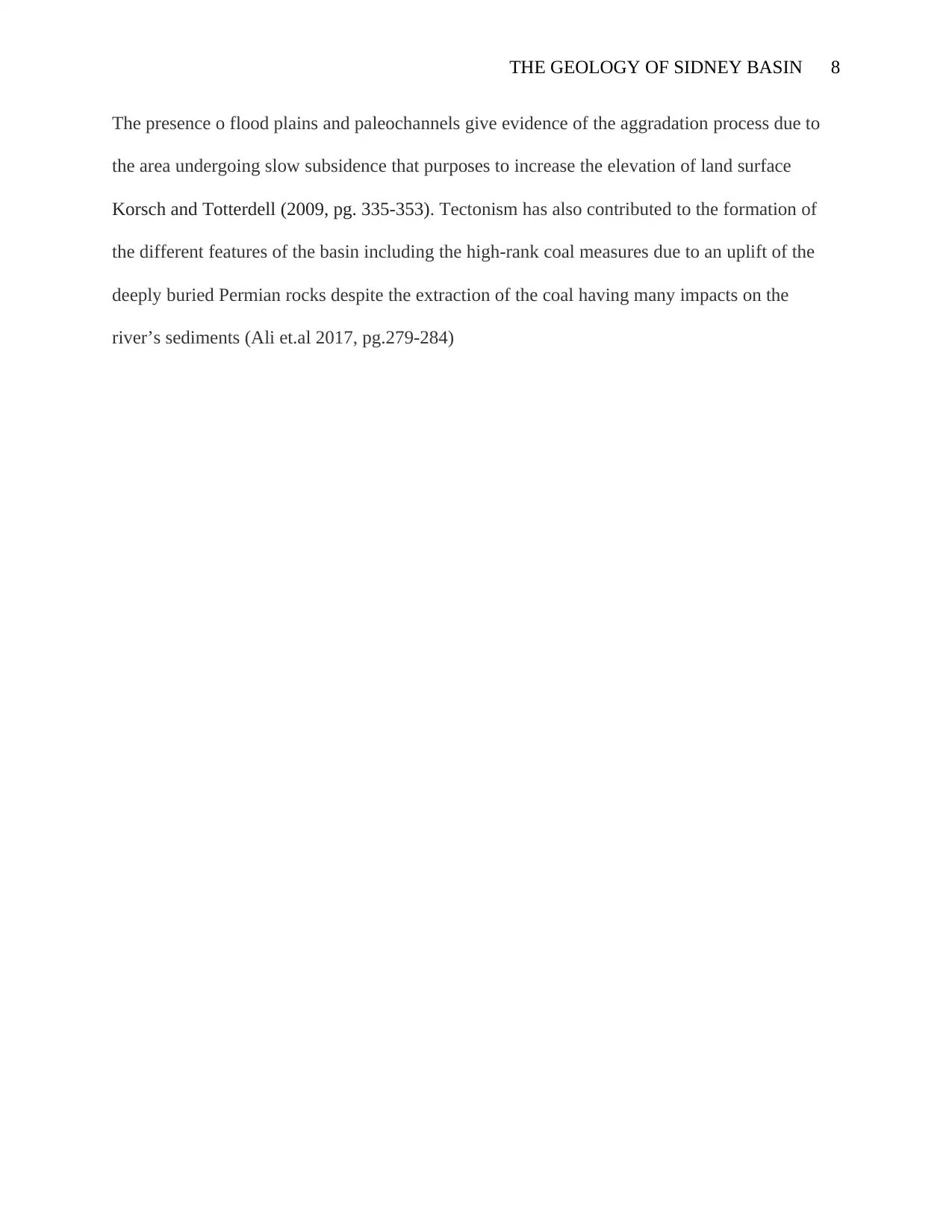
THE GEOLOGY OF SIDNEY BASIN 8
The presence o flood plains and paleochannels give evidence of the aggradation process due to
the area undergoing slow subsidence that purposes to increase the elevation of land surface
Korsch and Totterdell (2009, pg. 335-353). Tectonism has also contributed to the formation of
the different features of the basin including the high-rank coal measures due to an uplift of the
deeply buried Permian rocks despite the extraction of the coal having many impacts on the
river’s sediments (Ali et.al 2017, pg.279-284)
The presence o flood plains and paleochannels give evidence of the aggradation process due to
the area undergoing slow subsidence that purposes to increase the elevation of land surface
Korsch and Totterdell (2009, pg. 335-353). Tectonism has also contributed to the formation of
the different features of the basin including the high-rank coal measures due to an uplift of the
deeply buried Permian rocks despite the extraction of the coal having many impacts on the
river’s sediments (Ali et.al 2017, pg.279-284)
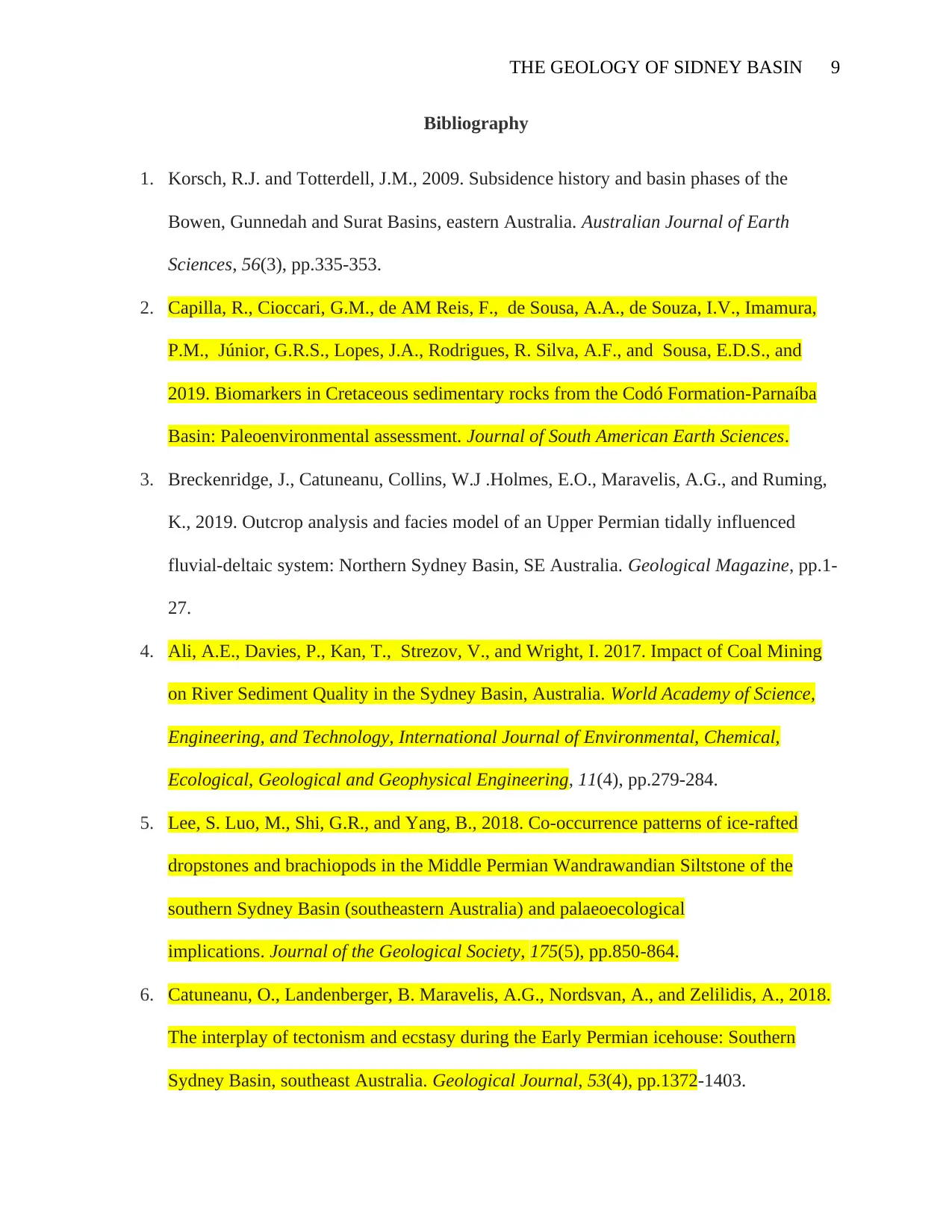
THE GEOLOGY OF SIDNEY BASIN 9
Bibliography
1. Korsch, R.J. and Totterdell, J.M., 2009. Subsidence history and basin phases of the
Bowen, Gunnedah and Surat Basins, eastern Australia. Australian Journal of Earth
Sciences, 56(3), pp.335-353.
2. Capilla, R., Cioccari, G.M., de AM Reis, F., de Sousa, A.A., de Souza, I.V., Imamura,
P.M., Júnior, G.R.S., Lopes, J.A., Rodrigues, R. Silva, A.F., and Sousa, E.D.S., and
2019. Biomarkers in Cretaceous sedimentary rocks from the Codó Formation-Parnaíba
Basin: Paleoenvironmental assessment. Journal of South American Earth Sciences.
3. Breckenridge, J., Catuneanu, Collins, W.J .Holmes, E.O., Maravelis, A.G., and Ruming,
K., 2019. Outcrop analysis and facies model of an Upper Permian tidally influenced
fluvial-deltaic system: Northern Sydney Basin, SE Australia. Geological Magazine, pp.1-
27.
4. Ali, A.E., Davies, P., Kan, T., Strezov, V., and Wright, I. 2017. Impact of Coal Mining
on River Sediment Quality in the Sydney Basin, Australia. World Academy of Science,
Engineering, and Technology, International Journal of Environmental, Chemical,
Ecological, Geological and Geophysical Engineering, 11(4), pp.279-284.
5. Lee, S. Luo, M., Shi, G.R., and Yang, B., 2018. Co-occurrence patterns of ice-rafted
dropstones and brachiopods in the Middle Permian Wandrawandian Siltstone of the
southern Sydney Basin (southeastern Australia) and palaeoecological
implications. Journal of the Geological Society, 175(5), pp.850-864.
6. Catuneanu, O., Landenberger, B. Maravelis, A.G., Nordsvan, A., and Zelilidis, A., 2018.
The interplay of tectonism and ecstasy during the Early Permian icehouse: Southern
Sydney Basin, southeast Australia. Geological Journal, 53(4), pp.1372-1403.
Bibliography
1. Korsch, R.J. and Totterdell, J.M., 2009. Subsidence history and basin phases of the
Bowen, Gunnedah and Surat Basins, eastern Australia. Australian Journal of Earth
Sciences, 56(3), pp.335-353.
2. Capilla, R., Cioccari, G.M., de AM Reis, F., de Sousa, A.A., de Souza, I.V., Imamura,
P.M., Júnior, G.R.S., Lopes, J.A., Rodrigues, R. Silva, A.F., and Sousa, E.D.S., and
2019. Biomarkers in Cretaceous sedimentary rocks from the Codó Formation-Parnaíba
Basin: Paleoenvironmental assessment. Journal of South American Earth Sciences.
3. Breckenridge, J., Catuneanu, Collins, W.J .Holmes, E.O., Maravelis, A.G., and Ruming,
K., 2019. Outcrop analysis and facies model of an Upper Permian tidally influenced
fluvial-deltaic system: Northern Sydney Basin, SE Australia. Geological Magazine, pp.1-
27.
4. Ali, A.E., Davies, P., Kan, T., Strezov, V., and Wright, I. 2017. Impact of Coal Mining
on River Sediment Quality in the Sydney Basin, Australia. World Academy of Science,
Engineering, and Technology, International Journal of Environmental, Chemical,
Ecological, Geological and Geophysical Engineering, 11(4), pp.279-284.
5. Lee, S. Luo, M., Shi, G.R., and Yang, B., 2018. Co-occurrence patterns of ice-rafted
dropstones and brachiopods in the Middle Permian Wandrawandian Siltstone of the
southern Sydney Basin (southeastern Australia) and palaeoecological
implications. Journal of the Geological Society, 175(5), pp.850-864.
6. Catuneanu, O., Landenberger, B. Maravelis, A.G., Nordsvan, A., and Zelilidis, A., 2018.
The interplay of tectonism and ecstasy during the Early Permian icehouse: Southern
Sydney Basin, southeast Australia. Geological Journal, 53(4), pp.1372-1403.
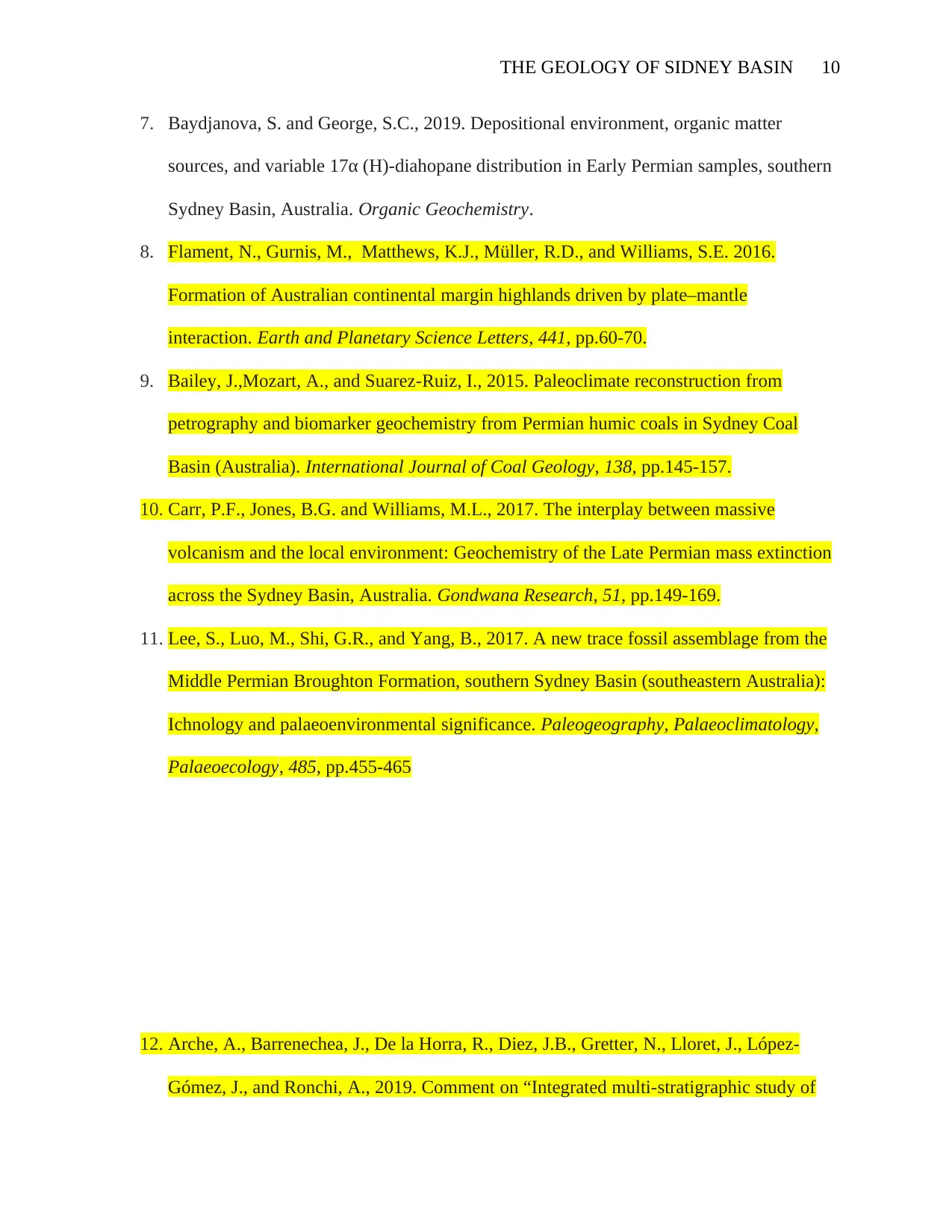
THE GEOLOGY OF SIDNEY BASIN 10
7. Baydjanova, S. and George, S.C., 2019. Depositional environment, organic matter
sources, and variable 17α (H)-diahopane distribution in Early Permian samples, southern
Sydney Basin, Australia. Organic Geochemistry.
8. Flament, N., Gurnis, M., Matthews, K.J., Müller, R.D., and Williams, S.E. 2016.
Formation of Australian continental margin highlands driven by plate–mantle
interaction. Earth and Planetary Science Letters, 441, pp.60-70.
9. Bailey, J.,Mozart, A., and Suarez-Ruiz, I., 2015. Paleoclimate reconstruction from
petrography and biomarker geochemistry from Permian humic coals in Sydney Coal
Basin (Australia). International Journal of Coal Geology, 138, pp.145-157.
10. Carr, P.F., Jones, B.G. and Williams, M.L., 2017. The interplay between massive
volcanism and the local environment: Geochemistry of the Late Permian mass extinction
across the Sydney Basin, Australia. Gondwana Research, 51, pp.149-169.
11. Lee, S., Luo, M., Shi, G.R., and Yang, B., 2017. A new trace fossil assemblage from the
Middle Permian Broughton Formation, southern Sydney Basin (southeastern Australia):
Ichnology and palaeoenvironmental significance. Paleogeography, Palaeoclimatology,
Palaeoecology, 485, pp.455-465
12. Arche, A., Barrenechea, J., De la Horra, R., Diez, J.B., Gretter, N., Lloret, J., López-
Gómez, J., and Ronchi, A., 2019. Comment on “Integrated multi-stratigraphic study of
7. Baydjanova, S. and George, S.C., 2019. Depositional environment, organic matter
sources, and variable 17α (H)-diahopane distribution in Early Permian samples, southern
Sydney Basin, Australia. Organic Geochemistry.
8. Flament, N., Gurnis, M., Matthews, K.J., Müller, R.D., and Williams, S.E. 2016.
Formation of Australian continental margin highlands driven by plate–mantle
interaction. Earth and Planetary Science Letters, 441, pp.60-70.
9. Bailey, J.,Mozart, A., and Suarez-Ruiz, I., 2015. Paleoclimate reconstruction from
petrography and biomarker geochemistry from Permian humic coals in Sydney Coal
Basin (Australia). International Journal of Coal Geology, 138, pp.145-157.
10. Carr, P.F., Jones, B.G. and Williams, M.L., 2017. The interplay between massive
volcanism and the local environment: Geochemistry of the Late Permian mass extinction
across the Sydney Basin, Australia. Gondwana Research, 51, pp.149-169.
11. Lee, S., Luo, M., Shi, G.R., and Yang, B., 2017. A new trace fossil assemblage from the
Middle Permian Broughton Formation, southern Sydney Basin (southeastern Australia):
Ichnology and palaeoenvironmental significance. Paleogeography, Palaeoclimatology,
Palaeoecology, 485, pp.455-465
12. Arche, A., Barrenechea, J., De la Horra, R., Diez, J.B., Gretter, N., Lloret, J., López-
Gómez, J., and Ronchi, A., 2019. Comment on “Integrated multi-stratigraphic study of
Secure Best Marks with AI Grader
Need help grading? Try our AI Grader for instant feedback on your assignments.
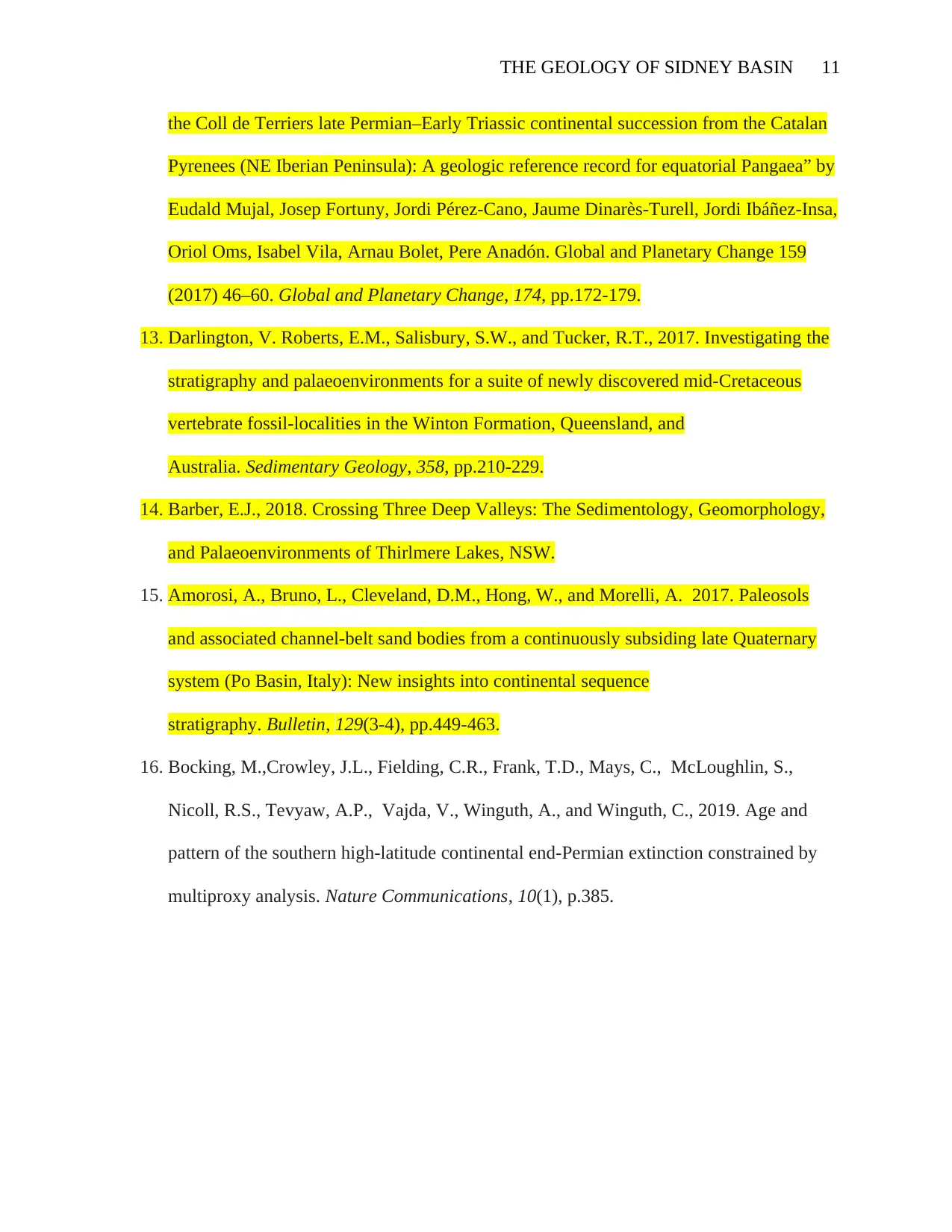
THE GEOLOGY OF SIDNEY BASIN 11
the Coll de Terriers late Permian–Early Triassic continental succession from the Catalan
Pyrenees (NE Iberian Peninsula): A geologic reference record for equatorial Pangaea” by
Eudald Mujal, Josep Fortuny, Jordi Pérez-Cano, Jaume Dinarès-Turell, Jordi Ibáñez-Insa,
Oriol Oms, Isabel Vila, Arnau Bolet, Pere Anadón. Global and Planetary Change 159
(2017) 46–60. Global and Planetary Change, 174, pp.172-179.
13. Darlington, V. Roberts, E.M., Salisbury, S.W., and Tucker, R.T., 2017. Investigating the
stratigraphy and palaeoenvironments for a suite of newly discovered mid-Cretaceous
vertebrate fossil-localities in the Winton Formation, Queensland, and
Australia. Sedimentary Geology, 358, pp.210-229.
14. Barber, E.J., 2018. Crossing Three Deep Valleys: The Sedimentology, Geomorphology,
and Palaeoenvironments of Thirlmere Lakes, NSW.
15. Amorosi, A., Bruno, L., Cleveland, D.M., Hong, W., and Morelli, A. 2017. Paleosols
and associated channel-belt sand bodies from a continuously subsiding late Quaternary
system (Po Basin, Italy): New insights into continental sequence
stratigraphy. Bulletin, 129(3-4), pp.449-463.
16. Bocking, M.,Crowley, J.L., Fielding, C.R., Frank, T.D., Mays, C., McLoughlin, S.,
Nicoll, R.S., Tevyaw, A.P., Vajda, V., Winguth, A., and Winguth, C., 2019. Age and
pattern of the southern high-latitude continental end-Permian extinction constrained by
multiproxy analysis. Nature Communications, 10(1), p.385.
the Coll de Terriers late Permian–Early Triassic continental succession from the Catalan
Pyrenees (NE Iberian Peninsula): A geologic reference record for equatorial Pangaea” by
Eudald Mujal, Josep Fortuny, Jordi Pérez-Cano, Jaume Dinarès-Turell, Jordi Ibáñez-Insa,
Oriol Oms, Isabel Vila, Arnau Bolet, Pere Anadón. Global and Planetary Change 159
(2017) 46–60. Global and Planetary Change, 174, pp.172-179.
13. Darlington, V. Roberts, E.M., Salisbury, S.W., and Tucker, R.T., 2017. Investigating the
stratigraphy and palaeoenvironments for a suite of newly discovered mid-Cretaceous
vertebrate fossil-localities in the Winton Formation, Queensland, and
Australia. Sedimentary Geology, 358, pp.210-229.
14. Barber, E.J., 2018. Crossing Three Deep Valleys: The Sedimentology, Geomorphology,
and Palaeoenvironments of Thirlmere Lakes, NSW.
15. Amorosi, A., Bruno, L., Cleveland, D.M., Hong, W., and Morelli, A. 2017. Paleosols
and associated channel-belt sand bodies from a continuously subsiding late Quaternary
system (Po Basin, Italy): New insights into continental sequence
stratigraphy. Bulletin, 129(3-4), pp.449-463.
16. Bocking, M.,Crowley, J.L., Fielding, C.R., Frank, T.D., Mays, C., McLoughlin, S.,
Nicoll, R.S., Tevyaw, A.P., Vajda, V., Winguth, A., and Winguth, C., 2019. Age and
pattern of the southern high-latitude continental end-Permian extinction constrained by
multiproxy analysis. Nature Communications, 10(1), p.385.
1 out of 11
Your All-in-One AI-Powered Toolkit for Academic Success.
+13062052269
info@desklib.com
Available 24*7 on WhatsApp / Email
![[object Object]](/_next/static/media/star-bottom.7253800d.svg)
Unlock your academic potential
© 2024 | Zucol Services PVT LTD | All rights reserved.